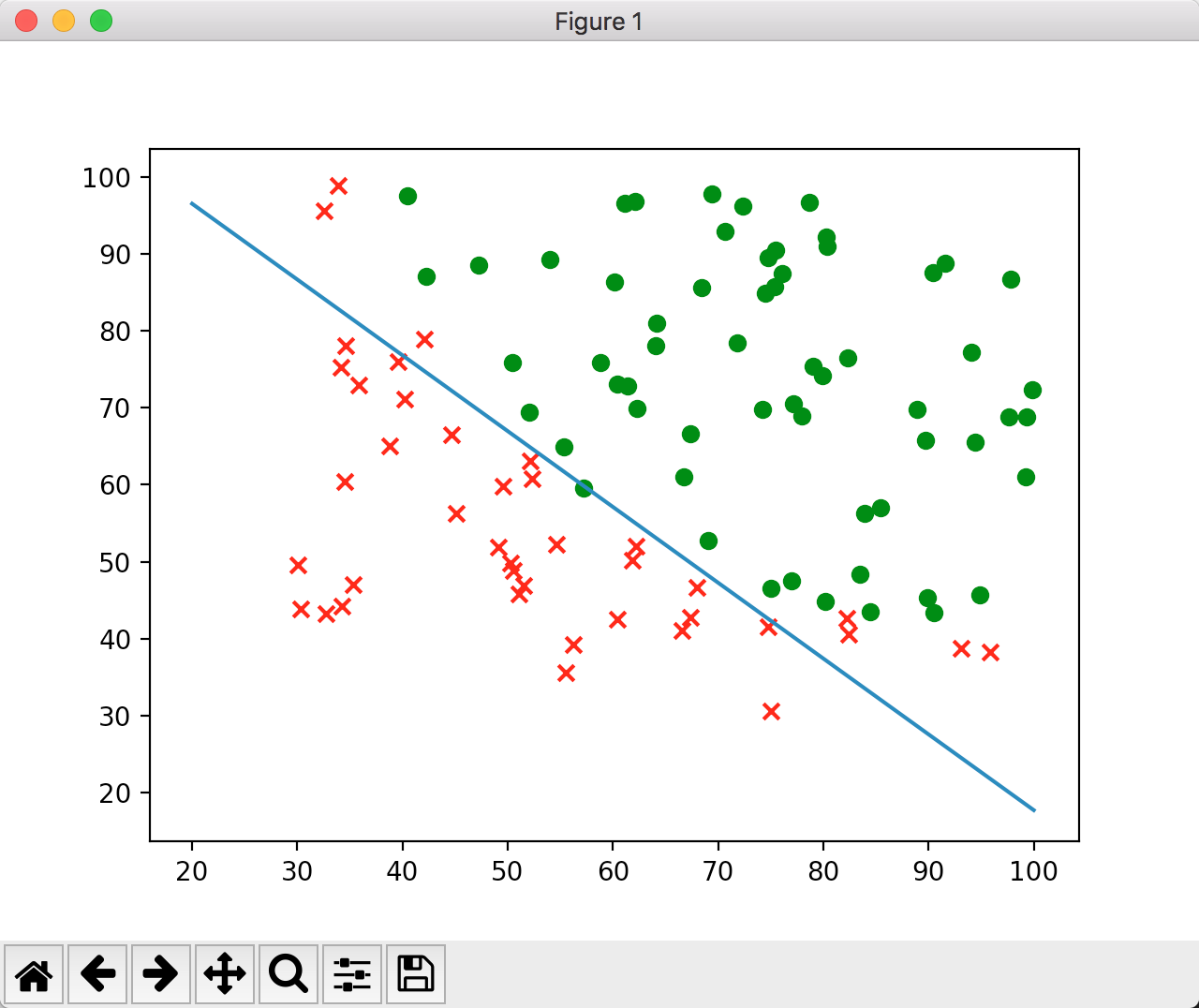#!/usr/local/bin/python3
##ljj [2]
##logic classify model
import tensorflow as tf
import matplotlib.pyplot as plt
import pandas as pd
import numpy as np
data_set = pd.read_csv('LogiReg_data.txt',sep=',')
#data_set.describe()
w = tf.Variable(tf.random_normal([2,1]),dtype="float32")
b = tf.Variable(tf.random_normal([1]),dtype="float32")
y = tf.placeholder(tf.float32)
x = tf.placeholder(tf.float32,shape=(1,2))
loss_list = []
with tf.Session() as sess:
#定义逻辑回归模型
logits = tf.add(tf.matmul(x,w),b)
y_predict = tf.nn.sigmoid(logits)
loss = tf.reduce_sum(tf.nn.sigmoid_cross_entropy_with_logits(logits=logits,labels=y))
train = tf.train.AdamOptimizer(0.001).minimize(loss)
sess.run(tf.global_variables_initializer())
for j in range(1500):
#shuffle data_set
#index = np.random.permutation(100)
#data_set = data_set.reindex(index)
for i in range(100):
w_,b_,loss_,_ = sess.run([w,b,loss,train],feed_dict={x:data_set[i:i+1][['math','english']],y:data_set[i:i+1][['result']]})
if j%100==0:
print('epoch={}, w={},b={},loss={}'.format(j,w_,b_,loss_))
loss_list.append(loss_)
print('final result : ')
print('w={},b={},loss={}'.format(w_,b_,loss_))
train_data = data_set.values
x1 = train_data[:,0]
x2 = train_data[:,1]
y = train_data[:,-1:]
for x1p, x2p, yp in zip(x1, x2, y):
if yp == 0:
plt.scatter(x1p, x2p, marker='x', c='r')
else:
plt.scatter(x1p, x2p, marker='o', c='g')
# 根据参数得到直线
x = np.linspace(20, 100, 10)
y = []
for i in x:
y.append((i * -w_[1] - b_) / w_[0])
plt.plot(x, y)
plt.show()
运行输出:
ljjdeMBP:logic_classify lingjiajun$ ./logic_regression.py
/usr/local/Cellar/python3/3.6.2/Frameworks/Python.framework/Versions/3.6/lib/python3.6/importlib/_bootstrap.py:205: RuntimeWarning: compiletime version 3.5 of module 'tensorflow.python.framework.fast_tensor_util' does not match runtime version 3.6
return f(*args, **kwds)
2018-05-06 21:48:14.420588: I tensorflow/core/platform/cpu_feature_guard.cc:137] Your CPU supports instructions that this TensorFlow binary was not compiled to use: SSE4.1 SSE4.2 AVX AVX2 FMA
epoch=0, w=[[-0.87034857]
[ 0.13095166]],b=[ 1.48850453],loss=52.04541015625
epoch=100, w=[[ 0.01144427]
[ 0.0005749 ]],b=[ 0.58342618],loss=0.21249079704284668
epoch=200, w=[[ 0.02113499]
[ 0.01194377]],b=[-0.85776216],loss=0.16103345155715942
epoch=300, w=[[ 0.03020949]
[ 0.02251359]],b=[-2.18144464],loss=0.12141948938369751
epoch=400, w=[[ 0.03859403]
[ 0.03212684]],b=[-3.3784802],loss=0.092116579413414
epoch=500, w=[[ 0.04626059]
[ 0.04076466]],b=[-4.4525094],loss=0.07090871036052704
epoch=600, w=[[ 0.05323409]
[ 0.04850558]],b=[-5.41535854],loss=0.05559533089399338
epoch=700, w=[[ 0.059574 ]
[ 0.05546409]],b=[-6.28165531],loss=0.04442552104592323
epoch=800, w=[[ 0.06535295]
[ 0.06175429]],b=[-7.06552744],loss=0.03614450991153717
epoch=900, w=[[ 0.07064275]
[ 0.067476 ]],b=[-7.77926588],loss=0.029891693964600563
epoch=1000, w=[[ 0.07550841]
[ 0.07271299]],b=[-8.43318176],loss=0.02508264034986496
epoch=1100, w=[[ 0.08000626]
[ 0.07753391]],b=[-9.0357523],loss=0.021319210529327393
epoch=1200, w=[[ 0.08418395]
[ 0.0819957 ]],b=[-9.59397316],loss=0.01832636632025242
epoch=1300, w=[[ 0.08808059]
[ 0.08614379]],b=[-10.11344337],loss=0.015911955386400223
epoch=1400, w=[[ 0.09172987]
[ 0.09001698]],b=[-10.59893036],loss=0.01393833290785551
final result :
w=[[ 0.09512767]
[ 0.09361333]],b=[-11.05011368],loss=0.012320424430072308
